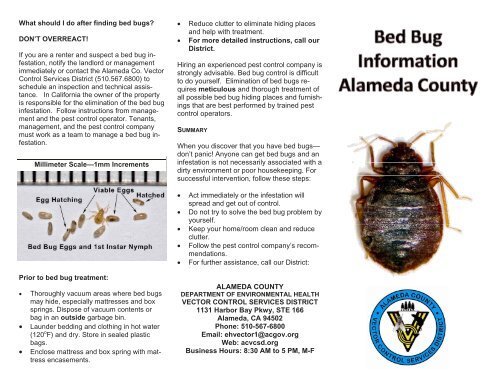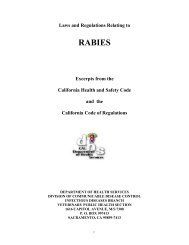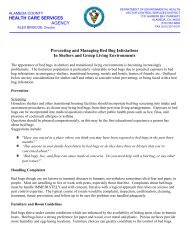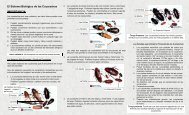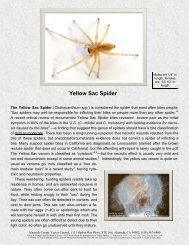What should I do after finding bed bugs - Vector Control Services ...
What should I do after finding bed bugs - Vector Control Services ...
What should I do after finding bed bugs - Vector Control Services ...
You also want an ePaper? Increase the reach of your titles
YUMPU automatically turns print PDFs into web optimized ePapers that Google loves.
<strong>What</strong> <strong>should</strong> I <strong>do</strong> <strong>after</strong> <strong>finding</strong> <strong>bed</strong> <strong>bugs</strong>?<br />
DON’T OVERREACT!<br />
If you are a renter and suspect a <strong>bed</strong> bug infestation,<br />
notify the landlord or management<br />
immediately or contact the Alameda Co. <strong>Vector</strong><br />
<strong>Control</strong> <strong>Services</strong> District (510.567.6800) to<br />
schedule an inspection and technical assistance.<br />
In California the owner of the property<br />
is responsible for the elimination of the <strong>bed</strong> bug<br />
infestation. Follow instructions from management<br />
and the pest control operator. Tenants,<br />
management, and the pest control company<br />
must work as a team to manage a <strong>bed</strong> bug infestation.<br />
Millimeter Scale—1mm Increments<br />
Reduce clutter to eliminate hiding places<br />
and help with treatment.<br />
For more detailed instructions, call our<br />
District.<br />
Hiring an experienced pest control company is<br />
strongly advisable. Bed bug control is difficult<br />
to <strong>do</strong> yourself. Elimination of <strong>bed</strong> <strong>bugs</strong> requires<br />
meticulous and thorough treatment of<br />
all possible <strong>bed</strong> bug hiding places and furnishings<br />
that are best performed by trained pest<br />
control operators.<br />
SUMMARY<br />
When you discover that you have <strong>bed</strong> <strong>bugs</strong>—<br />
<strong>do</strong>n’t panic! Anyone can get <strong>bed</strong> <strong>bugs</strong> and an<br />
infestation is not necessarily associated with a<br />
dirty environment or poor housekeeping. For<br />
successful intervention, follow these steps:<br />
<br />
<br />
<br />
<br />
<br />
Act immediately or the infestation will<br />
spread and get out of control.<br />
Do not try to solve the <strong>bed</strong> bug problem by<br />
yourself.<br />
Keep your home/room clean and reduce<br />
clutter.<br />
Follow the pest control company’s recommendations.<br />
For further assistance, call our District:<br />
Prior to <strong>bed</strong> bug treatment:<br />
<br />
<br />
<br />
Thoroughly vacuum areas where <strong>bed</strong> <strong>bugs</strong><br />
may hide, especially mattresses and box<br />
springs. Dispose of vacuum contents or<br />
bag in an outside garbage bin.<br />
Launder <strong>bed</strong>ding and clothing in hot water<br />
(120 o F) and dry. Store in sealed plastic<br />
bags.<br />
Enclose mattress and box spring with mattress<br />
encasements.<br />
ALAMEDA COUNTY<br />
DEPARTMENT OF ENVIRONMENTAL HEALTH<br />
VECTOR CONTROL SERVICES DISTRICT<br />
1131 Harbor Bay Pkwy, STE 166<br />
Alameda, CA 94502<br />
Phone: 510-567-6800<br />
Email: ehvector1@acgov.org<br />
Web: acvcsd.org<br />
Business Hours: 8:30 AM to 5 PM, M-F
Introduction<br />
BED BUGS<br />
(Cimex lectularis)<br />
Though once rare in Alameda County, <strong>bed</strong> bug<br />
infestations have become fairly common. Bed<strong>bugs</strong><br />
are easily transported in infested clothing,<br />
mattresses, and upholstered furniture. Additionally,<br />
<strong>bed</strong> <strong>bugs</strong> can be acquired when using<br />
public transport, at public gatherings (i.e. theaters),<br />
purchasing used furniture and clothing, or<br />
traveling to or visiting infested places.<br />
General Characteristics<br />
Bed <strong>bugs</strong> range in size from 1/16 in. (1.5 mm)<br />
as an immature to 1/4 in. (6 mm) as an adult.<br />
Adults are wingless with a flattened, oval<br />
shape, and dusky red in color. After feeding,<br />
their bodies can elongate to 3/8 in. (8 mm).<br />
The <strong>bed</strong> <strong>bugs</strong> have a beak specialized for<br />
sucking blood. However, <strong>bed</strong> <strong>bugs</strong> are not<br />
known to transmit disease to humans.<br />
<br />
<br />
<br />
<br />
Bed <strong>bugs</strong> tend to congregate and hide in<br />
confined spaces such as cracks, crevices,<br />
behind peeling paint, wall hangings, folds<br />
and under buttons of mattresses, sofas,<br />
and furniture.<br />
Bed <strong>bugs</strong> are usually nocturnal.<br />
Bed <strong>bugs</strong> can travel long distances searching<br />
for a blood meal but are usually found<br />
near the host.<br />
Bed <strong>bugs</strong> usually feed every 7 days or so.<br />
How <strong>do</strong> I know if I have <strong>bed</strong> <strong>bugs</strong>?<br />
Bed bug bites are painless, but may cause<br />
swelling and itching. Multiple bites are common.<br />
Some individuals <strong>do</strong> not react to the bite<br />
and may not be aware of a <strong>bed</strong> bug infestation.<br />
Since these <strong>bugs</strong> are active at night and feed<br />
while the human host is sleeping, the first signs<br />
of an infestation is often indicated by the<br />
3 Week<br />
Old Bed<br />
Bug Bites<br />
Recent Bed<br />
Bug Bites<br />
This is a picture of “between the cushions” of a <strong>bed</strong> bug<br />
infested sofa. To the naked eye, you only see the larger<br />
<strong>bugs</strong>, but up-close you see the rest of the story...<br />
appearance of small blood (fecal) spots on light<br />
colored sleep wear and <strong>bed</strong> linen.<br />
Any house is a good habitat for <strong>bed</strong> <strong>bugs</strong>. The<br />
level of sanitation and maintenance can determine<br />
the size and extent of the pest population.<br />
Motels, hotels and other establishments with a<br />
constant turnover are more prone to infestations.<br />
Bed Bugs in<br />
Mattress Seam<br />
Bed Bug Biology<br />
<br />
<br />
<br />
<br />
Life cycle: egg – nymph –adults. Completed<br />
between 1 ½ to 5 months.<br />
The female lays up to 500 eggs in her lifetime,<br />
gluing eggs in batches of 5 or so in<br />
cracks and crevices.<br />
Eggs are resistant to pesticides.<br />
Nymphs and adults can survive 6-8 months<br />
without feeding especially at low temperatures<br />
(64⁰ F).<br />
Blood Spots From<br />
Bed Bug Feeding<br />
Where to look?<br />
Look for nymphs, adults, skin casings, fecal<br />
spots, and blood spots on seams, tufts, or folds<br />
of mattresses, box frame, <strong>bed</strong> frame, head<br />
board, adjacent furniture, walls, baseboards,<br />
and <strong>do</strong>or and win<strong>do</strong>w casings and trim, wall<br />
hangings, furniture, drapes.


